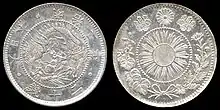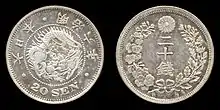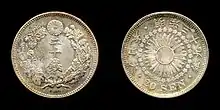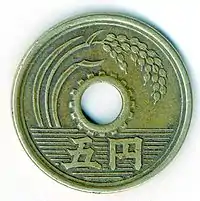20 sen coin
The 20 sen coin (二十銭銀貨) was a Japanese coin worth one fifth of a Japanese yen, as 100 sen equalled 1 yen.[1] These coins were minted in silver during the Meiji era from 1870 to 1911.[2][3]
Japan | |
| Value | 1⁄5 Japanese Yen |
|---|---|
| Edge | Reeded |
| Shape | Circular |
| Composition | 80% Silver 20% Copper |
| Years of minting | 1870–1911 |
| Obverse | |
| Design | Various, depending on year. |
| Reverse | |
| Design | Various, depending on year. |
History
Meiji coinage (1870–1911)
Twenty sen coins were first struck towards the end of 1870 (year 3 of Meiji) from a newly established mint at Osaka.[4][5] This was initially done by engineers from the United Kingdom, as Japan did not have the technology or raw materials to manufacture new coins.[6][7] The coins made during this time were not officially released for circulation until the following year (1871) after a new currency act was promulgated.[8] Twenty sen coins along with twelve other denominations were adopted by the Meiji government in an act signed on June 27, 1871.[9][10] This new coinage gave Japan a western style decimal system based on units of yen, which were broken down into subsidiary currency of sen, and rin.[11][12] Twenty sen coins dated 1870 (year 3) were initially authorized to be struck in .800 silver, weighs 72.2 grains (4.68g), and has a 23.62mm diameter (0.93 in).[13][14][lower-alpha 1] The first design used is called rising sun dragon (旭日竜, Asahi Ryu), which had its features engraved by a commission of Japanese artists.[6] This design features a dragon with an open mouth on the obverse, while the reverse has a paulownia decoration with a sunburst in the center with the chrysanthemum seal up on top. Twenty sen coins were initially legal tender only up to the amount of 10 yen which was fixed by government regulations.[17] The amount of silver in the coin soon became an issue as their weight per face value became lighter than the silver 1 yen coin. An amendment to the new currency act (Daijo-kan Declaration No. 341 (新貨幣量目寸法改正)) was adopted in November 1872 (year 5) which intended to increase the weight of the twenty sen coin. This action was never carried out as the new currency act was amended again towards the beginning of the next year.[8] Changes to the weight, size, and design of the coins were implemented in February 1873 (year 6) by Daijo-kan Declaration No. 46.[18] The weight issue was resolved by adjusting the coin from 72.2 to 83.2 grains (5.4g), this step was done to avoid any public mistrust on the silver content.[13][14][19] Twenty sen coins were also reduced slightly in size from 24mm to 22.42mm.[18] The second design is called dragon silver 20 sen (竜二十銭銀貨) as the sunburst on the reverse was replaced by a wreath. Latin script is used for the first time with "20 SEN" on the obverse under the dragon, and the medallic orientation was flipped.[18][20]
It is recorded by Edward Reed that production of twenty sen coins continued until at least June 30, 1878.[21][22] These coins were last dated 1877 (year 10), and could have been impacted from the Satsuma Rebellion.[18] Only proof strikes were made for coins dated 1880 (year 13) for exclusive use in presentation sets.[23] During the next few years, Japan experienced a sharp drop in prices and contraction of the economy in response to high inflation caused by the Satsuma Rebellion.[24] Large amounts of devalued inconvertible notes were in circulation from the aftermath of the rebellion. The Bank of Japan was established in 1882 (year 15) to remedy the situation, and two years later convertible banknotes were issued.[24] An imperial ordinance was issued in June 1885 stating that silver payments would be resumed after January 1, 1886.[24][25] For reasons unknown there are no twenty sen coins dated 1889 or 1890 (year 22 and 23), during this time a special fund was created for the redemption in silver for all government notes.[25] The Japanese government promulgated the "currency law" (Meiji 30 Law No. 16) in 1897 which replaced the previous "new currency act". This law abolished the silver yen at which subsidiary silver coins were previously fixed at, and officially switched Japan from a silver standard to a gold standard. No changes were made to twenty sen coins as they were re-established to their previous weight, size, and design.[26]
Production continued as the price of silver bullion remained steady throughout the rest of the century. This changed when silver bullion began to rise sharply in 1903 (year 36) which threatened to exceed the face value of the twenty sen coin.[18][27] An amendment to the "currency law" was promulgated in March 1906 which lowered their size from 22.42mm to 20.3mm, and their weight from 5.4g to 4.1 grams.[27][28] The third and final design used on these smaller coins is called rising sun 20 sen (旭日20銭銀貨, Asahi Nijusen) as a sunburst design on the reverse was restored.[27] The wreath design previously used on the back side of the dragon coins was adopted for the obverse. Twenty sen coins were produced afterwards until 1911 (year 44), concluding the circulating portion of the series.
Taishō proposals (1918–1921)
Emperor Taishō was enthroned in 1912 following the death of Emperor Meiji. Coinage in general was impacted by World War I which broke out two years later, bringing Japan a booming economy due to a large trade surplus.[29] The negative effects from this event included an increased demand for subsidiary coins which led to a coin shortage.[30][31] Silver bullion was in high demand causing prices to rise above the face value of the twenty sen coin.[27] The Japanese government responded by taking measures to temporary ban the export of silver. These efforts were ultimately unsuccessful which led to the issuance of 20 sen emergency banknotes in November 1917.[27][29] As the price of silver rose, the issue of coinage was also addressed for twenty and fifty sen coins. The "currency law" was revised in May 1918 (Law No. 42) to lower the silver content in twenty sen coins to 72% silver and 28% copper.[32] Other changes included a reduction in size from 20.3mm to 16.7mm, and in weight from 4.1 to 3 grams.[33] The coins struck from 1918 to 1921 are known as Yatagarasu sen (八咫烏銭, eight-span crow sen) after the design featured on them.[33][lower-alpha 2] None of these proposed coins were ever released for circulation through the Bank of Japan as they were trial or pattern strikes.[27][33][35] Twenty sen banknotes were last issued in 1919 and were allowed to circulate until their suspension on April 1, 1921.[36][37] By this time, efforts to re-establish the twenty sen coin were abandoned as silver bullion rose above their face value again.[27] Twenty sen coins were eventually demonetized at the end of 1953 when the Japanese government passed a law abolishing subsidiary coinage in favor of the yen.[38] Currencies of less than one yen were rarely used by this time due to excessive post-war inflation.[39]
Weight and size
| Minted | Size | Weight |
|---|---|---|
| 1870–1871[16] | 24.0mm | 5.0g |
| 1873–1905[16] | 22.4mm | 5.4g |
| 1906–1911[16] | 20.3mm | 4.1g |
Circulation figures

Design 1 - (1870 - 1871)

Design 2 - (1873 - 1905)

Design 3 - (1906 - 1911)
Meiji
The following are circulation figures for the twenty sen coin, all of which were minted between the 3rd, and 44th year of Meiji's reign. The dates all begin with the Japanese symbol 明治 (Meiji), followed by the year of his reign the coin was minted. Each coin is read clockwise from right to left, so in the example used below "一十二" would read as "year 21" or 1888.
- "Year" ← "Number representing year of reign" ← "Emperor's name" (Ex: 年 ← 一十二 ← 治明)
| Year of reign | Japanese date | Gregorian date | Mintage[3] |
|---|---|---|---|
| 3rd | 三 | 1870[lower-alpha 3] | 4,313,015[40] |
| 4th | 四 | 1871[lower-alpha 4] | |
| 6th | 六 | 1873[lower-alpha 5] | 6,214,284[41] |
| 7th | 七 | 1874 | 3,024,242[41] |
| 8th | 八 | 1875[lower-alpha 6] | 612,736[41] |
| 9th | 九 | 1876[lower-alpha 6] | 9,200,892[41] |
| 10th | 十 | 1877 | 5,199,731[41] |
| 13th | 三十 | 1880 | 96[lower-alpha 7] |
| 18th | 八十 | 1885 | 4,205,723[41] |
| 20th | 十二 | 1887 | 4,794,755[41] |
| 21st | 一十二 | 1888 | 703,920[41] |
| 24th | 四十二 | 1891 | 2,500,000[41] |
| 25th | 五十二 | 1892 | 3,054,693[41] |
| 26th | 六十二 | 1893 | 3,445,307[41] |
| 27th | 七十二 | 1894 | 4,500,000[41] |
| 28th | 八十二 | 1895 | 7,000,000[41] |
| 29th | 九十二 | 1896 | 2,599,340[41] |
| 30th | 十三 | 1897 | 7,516,448[41] |
| 31st | 一十三 | 1898 | 17,984,212[41] |
| 32nd | 二十三 | 1899 | 15,000,000[41] |
| 33rd | 三十三 | 1900 | 800,000[41] |
| 34th | 四十三 | 1901 | 500,000[41] |
| 37th | 七十三 | 1904 | 5,250,000[41] |
| 38th | 八十三 | 1905 | 8,444,930[41] |
| 39th | 九十三 | 1906 | 6,550,070[42] |
| 40th | 十四 | 1907 | 20,000,000[42] |
| 41st | 一十四 | 1908 | 15,000,000[42] |
| 42nd | 二十四 | 1909 | 8,824,702[42] |
| 43rd | 三十四 | 1910 | 21,175,298[42] |
| 44th | 四十四 | 1911 | 500,000[42] |
Collecting
The value of any given coin is determined by survivability rate and condition as collectors in general prefer uncleaned appealing coins. Twenty sen coins make up a relatively short lived denomination which is confined to the Meiji era. The first coins minted use the Asahi Ryu or rising sun dragon design which only lasted two years (1870-1871). As with the other denominations, those with clear (deep) scales on the dragon's design are worth more than obscure (shallow) ones.[8][43] Coins dated 1871 (year 4) also have two varieties which include the character 銭 (sen) with a missing stroke.[44] As these coins are scarce they are valued more than double the price than those with the whole character present.[43] Aside from the deep scales and this incomplete sen variety, average circulated coins from these two years can be obtained for 4,000+ yen (~$40+ USD).[43] Those in uncirculated grades are considered to be rare with values in the tens of thousands of yen.[43] The second design was much longer lasting in comparison as it was featured on coins from 1873 to 1905 (year 6 to 38). Another similarity with other denominations occurs here with the character "明" in Meiji's name on the obverse. Coins dated 1873 (year 6) either have both features separated as the first variety, or have a line connecting both the left and right features as the second variety. There are also coins that are missing a top stroke on the left feature creating an "open" appearance versus those with a completed stroke.[46] Those with the second "connected" variety, and examples with a missing top stroke are worth more than their counterparts for this one year occurrence.
Twenty sen coins dated 1875 and 1876 (year 8 and 9) either have "long" ribbons or "short" ribbons at the bottom of the wreath design. The "long" ribbons can be deafferented from the "short" design as the ribbons look flatter with more noticeable V shaped tails. "Type 1" long ribbons are more valuable on 1875 dated coins, while "Type 2" short ribbons are more for 1876. Twenty sen coins dated 1875 (year 8) are worth higher prices in general anyways as their mintage is low.[44] Some Japanese price guides do not assess the value of 1880 (year 13) coins as so few of them have survived.[18][44] An estimate places the value of these coins in the millions of yen ($10,000+ USD) where they are sold at auctions.[23] The production of twenty sen coins dated 1885 to 1905 (year 18 to 38) contains three key dates due to low mintage figures. These dates are: 1888, 1900, and 1901 (year 21, 33 and 34), and are valued in the tens of thousands of yen in average condition. Overall though, common years and dates for the second design type are valued in the low thousands of yen in average condition.[18] Twenty sen coins with the third and final design used from 1906 to 1911 (year 39 to 44) were generally made in larger amounts. Only a few of these coins show serious wear from circulation as the distribution period was short.[27] There is a single rarity here in the last date of the series (1911 aka year 44) as the mintage for that year was low.[47] Twenty sen trial or pattern strikes made under Emperor Taishō are extremely rare and are valued in the millions of yen.[33]
See also
Notes
- Modern sourcing places the diameter at 24mm (0.94 in) and the weight at 5 grams.[15][16]
- There is one 1918 (year 7) dated example which is distinctively different from the others featuring a wreath/sunburst design combination.[34]
- Two varieties were made in 1870 in regards to the depth of the dragon's scales (shallow and deep), their mintage is combined.
- Coins minted in 1871 have a scarce variety where the lower stroke in 銭 ("Sen") on the obverse is incomplete
- Two different types were made this year, their mintage is combined.
- Two varieties were made for 1875 and 1876 (year 8 and 9) dated coins, as they either feature "long" or "short" ribbons on the reverse. Their mintages are combined.
- Not intended for circulation.[23][41]
References
- John Crowdy (1873). "The British Almanac". Stationers' Company. pp. 112–113. Retrieved October 2, 2020.
- "20銭銀貨" (in Japanese). www.buntetsu.net. Retrieved December 5, 2016.
- Chester L. Krause & Clifford Mishler. Collecting World Coins 10th edition. Krause Publications. p. 431.
- John Eatwell (2016). Years-Estyate For Yen. Palgrave's Dictionary of Political Economy. Springer. p. 683.
- History - The First Period. Financial and Economic Annual of Japan. U.S. Government Printing Office. 1907. p. 25.
- "旭日竜十銭銀貨". Pepper's Square (in Japanese). Retrieved December 7, 2020.
- John Crowdy (1873). "The British Almanac". Stationers' Company. p. 112-113. Retrieved December 9, 2016.
- "旭日龍二十銭銀貨". Pepper's Square (in Japanese). Retrieved December 22, 2020.
- A. Piatt Andrew, Quarterly Journal of Economics, "The End of the Mexican Dollar", 18:3:321–356, 1904, p. 345
- Ministry of the Treasury (1871). 新貨条例 (in Japanese). National Archives of Japan.
- Brief History of Coinage Laws Since 1871. Annual Report of the Director of the United States Mint. United States Department of the Treasury. 1899. pp. 345–346.
- Wm. Crosby and H.P. Nicholes (1873). Coinage at Home and Abroad. The Bankers' Magazine, and Statistical Register. 27. p. 983.
- "The Japan Daily Mail". 1874. p. 71 & 745.
- Monetary System of Japan. United States Congressional Serial Set. 1738. U.S. Government Printing Office. 1877. p. 298.
- "Japan 20 Sen Y# 3 Yr.3(1870)". Numismatic Guaranty Corporation. Retrieved December 22, 2010.
- "20銭銀貨". www.buntetsu.net. Retrieved December 22, 2020.
- "Commercial Notes". Monthly Summary of Commerce and Finance of the United States. U.S. Government Printing Office. 1900. p. 2264.
- "竜二十銭銀貨 Dragon 20 Sen (Silver)". Pepper's Square (in Japanese). Retrieved December 22, 2020.
- "竜五銭銀貨". Pepper's Square (in Japanese). Retrieved December 22, 2020.
- Reiji Aoyama (1982). New Revised Money Notebook, History and Collection Guide for Japanese Coins. Bonanza. pp. 180–182.
- Meiji Financial History Compilation Society (1905). ""Meiji Financial History (Volume 11) Currency"". Meiji Financial History Publishing Office. pp. 449–451.
- Edward Reed (2012). The City of Osaka. Japan: Its History, Traditions, and Religions (With the Narrative of a Visit in 1879). Cambridge University Press. p. 154.
- "Meiji Proof 20 Sen Year 13 (1880)". Heritage Auctions. Retrieved December 22, 2020.
- United States. Bureau of the Mint (1900). Annual Report of the Director of the Mint. Department of the Treasury. p. 392-393.
- Alan Ripley Foote (1900). Public Policy: A Journal for the Correct Understanding of Public Questions and the Development of Good Citizenship. 2. p. 14-15.
- Japan (1897). "The Coinage Law of Japan, Enacted in 1897". p. 23-25.
- "旭日20銭銀貨 Rising Sun 20 Sen (Silver)". Pepper's Square (in Japanese). Retrieved December 23, 2020.
- The Japan Daily Mail. 1906. p. 228.
- "大正20銭券" (in Japanese). Buntetsu. Retrieved December 19, 2020.
- "桐一銭青銅貨 Kiri 1 Sen (Bronze)". Pepper's Square. Retrieved October 18, 2020.
- United States Department of the Treasury (1918). Annual Report of the Director of the Mint. Bureau of the Mint. p. 234.
- 貨幣法中改正 (大正七年). Ministry of Finance. 1918.
- "八咫烏20銭の価値と買取相場". Antique Coin Info (in Japanese). Retrieved December 24, 2020.
- "Taisho silver Pattern 20 Sen Year 7 (1918)". Heritage Auctions. Retrieved December 25, 2020.
- "八咫烏20銭銀貨の買取・査定相場(大正7年)". Antique Coin Info (in Japanese). Retrieved December 24, 2020.
- Great Britain. Department of Overseas Trade (1920). Report on Economic and Commercial Conditions in Japan. H.M. Stationery Office. p. 9.
The issue of 10 sen and 20 sen notes would be suspended after March 31st, 1921, except for the purpose of meeting the demands for exchange of soiled or damaged notes
- The Numismatist. 36. American Numismatic Association. 1923. p. 65.
- "小額通貨の整理及び支払金の端数計算に関する法律" [A law of the abolition of currencies in a small denomination and rounding off a fraction, July 15, 1953 Law No.60]. www.shugiin.go.jp. Archived from the original on June 28, 2002. Retrieved December 5, 2016.
- "1円未満のお金が使えなくなったのはいつからですか?". Bank of Japan (in Japanese). Retrieved October 27, 2020.
- "Japan 20 Sen Yr.3(1870)-Yr.4(1871)". Numismatic Guaranty Corporation. Retrieved December 5, 2016.
- "Japan 20 Sen Y# 24 Yr.10(1877)-Yr.9(1876)". Numismatic Guaranty Corporation. Retrieved December 5, 2016.
- "Japan 20 Sen Y# 30 Yr.39(1906)". Numismatic Guaranty Corporation. Retrieved December 14, 2020.
- "旭日竜20銭銀貨の買取相場・査定価格(明治3年〜4年)". Kosen Navi (in Japanese). Retrieved December 25, 2020.
- "20銭硬貨の買取価格とおすすめ買取業者について". Kosen Kaitori (in Japanese). Retrieved December 25, 2020.
- "明治の50銭と20銭銀貨の価値". Antique Coin Info (in Japanese). Retrieved December 25, 2020.
- "旭日20銭銀貨(二十銭硬貨)の買取相場・査定価格". Kosen Navi (in Japanese). Retrieved December 26, 2020.
